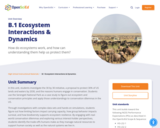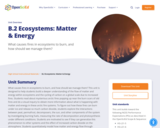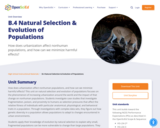
A video tutorial which demonstrates how average velocity can be shown using a positive or negative sign. [4:17]
- Subject:
- Science
- Material Type:
- Audio/Video
- Provider:
- Sophia Learning
- Date Added:
- 12/01/2023

A video tutorial which demonstrates how average velocity can be shown using a positive or negative sign. [4:17]

This lesson explains how average velocity can be represented by a positive or negative sign. It is 1 of 2 in the series titled "Average Velocity & Sign Notation." [6:44]

How do ecosystems work, and how can understanding them help us protect them? In this unit, students investigate the 30 by 30 initiative, a proposal to protect 30% of US lands and waters by 2030, and the reasons humans engage in conservation. Students use the Serengeti National Park as a case study to figure out ecosystem and conservation principles and apply those understandings to conservation dilemmas in the US.
OpenSciEd content is highly rated in EdReports and is aligned to NGSS standards.

What causes fires in ecosystems to burn, and how should we manage them? What causes fires in ecosystems to burn, and how should we manage them? This unit is designed to help students build a deeper understanding of the flow of matter and energy within ecosystems and the cycling of carbon on a global scale due to increased fires. Students read about mysterious arctic fires popping up near the burn scars of old fires and do a visual inquiry to obtain more information about what is happening with matter and energy in these arctic fire systems. To figure out how these fires can burn under ice and release so much carbon dioxide, students explore the interactions between peat, permafrost, decomposers, the sun, and other components of the system by investigating burning fuels, measuring the rate of decomposition and photosynthesis under different conditions. Students are motivated to see if they can generalize this phenomenon to other systems and the effect of increased carbon dioxide on the atmosphere. Students quantitatively model how matter and energy flow through different earth systems and different levels within an ecosystem. Finally, students use what they have figured out about positive feedback effects to design solutions to disrupt that flow of matter and energy in communities they care about.
OpenSciEd content is highly rated in EdReports and is aligned to NGSS standards.

How does urbanization affect nonhuman populations, and how can we minimize harmful effects? How does urbanization affect nonhuman populations, and how can we minimize harmful effects? This unit on natural selection and evolution of populations focuses on the phenomenon of increasing urbanization around the world and the impact of that change on nonhuman populations. Students investigate case studies that investigate fragmentation, poison, and proximity to humans as selection pressures that affect the relative fitness of individuals with particular anatomical, physiological, and behavioral traits in a population. Through investigations with complex data sets, they figure out how genetic diversity in a population allows populations to adapt to changes encountered in urban environments.
OpenSciEd content is highly rated in EdReports and is aligned to NGSS standards.

This is a good informational site about Alkalinity. It gives a good explanation of it and some examples.

Use this site to review information about forces, concentrating on balanced and unbalanced forces. The information is provided in an interactive activity. There is also a factsheet presenting information on balanced and unbalanced forces, and a practice test.

Investigate the changing states of water as you help Steve stay alive while in the Arctic. Includes background information about changing states of matter and about the water cycle, as well as a quiz.

Save Earth from the evil villain who is draining all the life from it. Following the activity, read more about rocks and soil, and then take a quick quiz to check for understanding.

Find out which material will save Steve from getting shocked by the electric eels. Following the activity, read more about electrical conductors, and then take a quick quiz to check for understanding.

Use your knowledge about friction to help Carrie get to the Invigatron before someone steals it. Following the activity, read more about friction and resistance, and then take a quick quiz to check for understanding.

This landing page includes learning modules on the following topics of: animals, plants, microorganisms, life cycles and reproductions, food chains, habits, humans and the environment, adaptation, inheritance, and evolution.

This ten question quiz will help you determine your understanding of the parts of a flower. Links are provided that allow you to increase the size of your quiz, see the quiz in different format, read background information prior to taking the quiz, and enjoy a fun activity.

A graphic which communicates the beauty and intricacy of DNA, illustrating how DNA is the core to everything. [3:25]

This video shows students involved in an activity in which they are pushing a chair with a weak, medium, and strong force, and using arrows to represent the size and direction of a force. [3:11]

In this video, students experiment with several moving objects and describe their initial ideas about what causes objects to start to move. [3:14]

This video shows a teacher supporting students in summarizing and synthesizing their ideas after experimenting with moving objects. [2:41]

In this video, students discuss their ideas about what might cause something to start moving. [4:26]